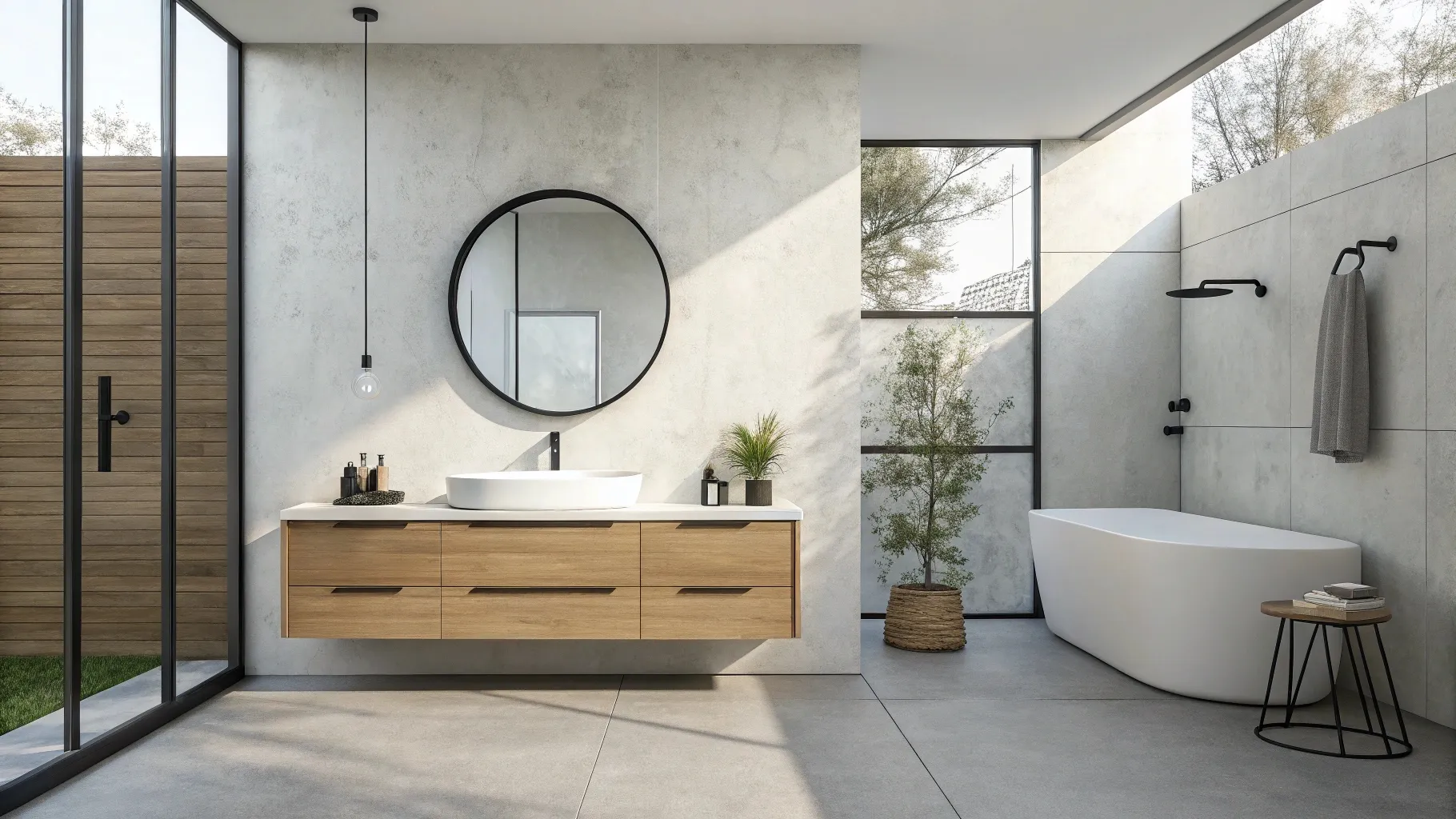Are you tired of unexpected costs ruining your hotel renovation budget? It is a pain when a simple vanity replacement turns into a financial headache. I know this pain.
For hotel projects, a full bathroom vanity replacement generally costs between $400 and $2,500 per unit, which includes the vanity, installation, plumbing work, and logistical expenses. Buyers often secure 20% to 40% discounts on the unit cost for bulk orders of 50 or more.
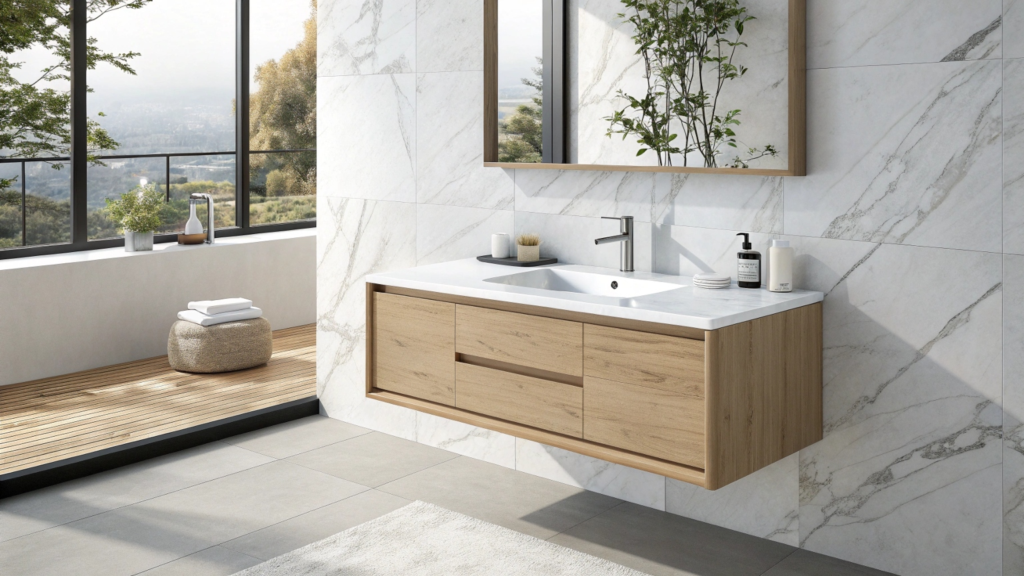
The real cost of a bathroom vanity goes far beyond the initial purchase price, especially when dealing with bulk orders for a large-scale renovation project like a hotel. I started my career in a factory and later ran a trading company, so I’ve seen exactly where costs balloon for buyers like you. You must consider everything from the raw material to the minute labor costs to truly master your project’s budget.
Table of Contents
Common bathroom vanity sizes available on the market, why do they matter?
Does the final invoice for vanity replacement shock you? It is shocking how quickly hidden costs add up. I want to help you stop the budget surprises.
Vanity replacement costs go up because of several factors, including:
- High-Quality Materials: Hotels need durable, moisture-resistant materials.
- Complex Logistics: Coordinating delivery and installation for many rooms.
- Labor & Rework: High labor costs and unexpected fixes for poor-quality products.
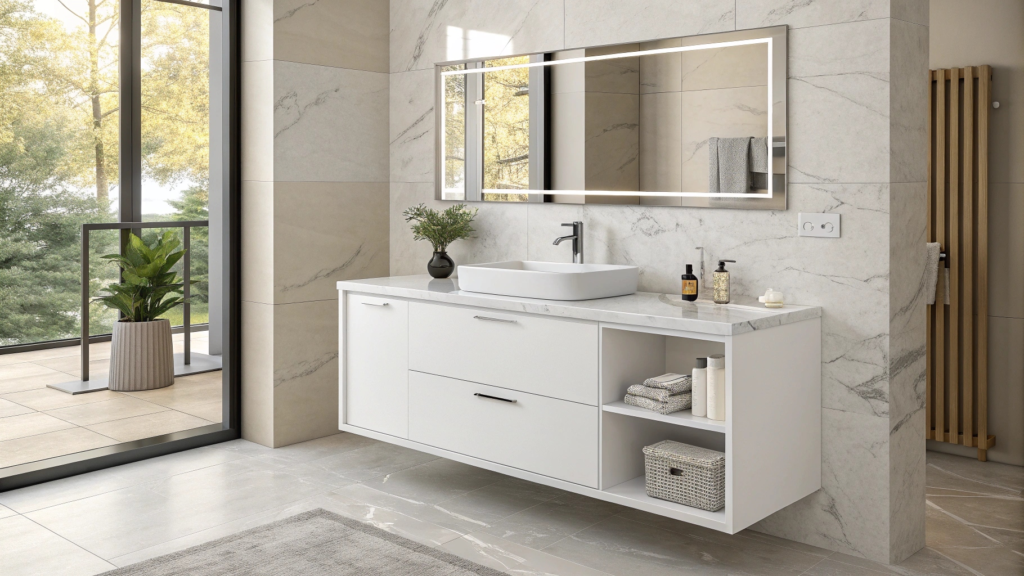
When I worked in the factory, I learned that the initial cost is only part of the story. Hotel procurement managers like Emma need vanities that last a long time to keep guests happy and minimize maintenance. Replacing a vanity in a hotel is expensive because it must be a quick, seamless process that does not disrupt guests or fall outside the renovation window. The price must reflect the lifecycle cost, not just the purchase price. Quality materials like solid wood, plywood, or stainless steel cost more, but they prevent swelling and warping that lead to expensive, early replacement. For bulk orders, the coordination and delivery logistics add significant cost because timing is everything in a renovation.
Key Drivers of High Replacement Cost
| Cost Component | Hotel Impact | Strategy for Wholesalers |
|---|---|---|
| Material Quality | Determines durability and lifespan. | Choose moisture-resistant Plywood or Stainless Steel. |
| Logistics & Delivery | Must align perfectly with the renovation schedule. | Select a supplier with proven on-time project delivery. |
| Labor & Rework | Poor quality leads to expensive, in-service repairs. | Demand case studies and quality certifications. |
| Customization | Specific hotel brand standards increase complexity. | Standardize designs across property types where possible. |
What Factors Affect the Cost of Replacing a Bathroom Vanity in Bulk?
It is tough to keep track of every expense. I understand this pressure on your bottom line.
The final cost of replacing many vanities depends on key factors:
- Material Selection: Plywood is usually cheaper than stainless steel.
- Scope of Work: Removing old units and full plumbing changes add to the labor cost.
- Bulk Discount: Order size directly impacts the unit price you pay.
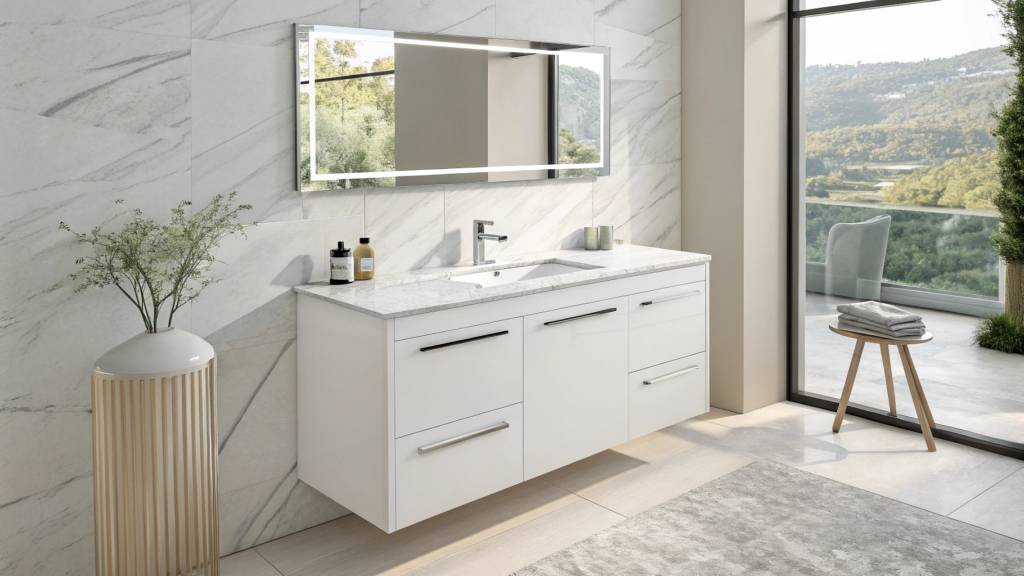
As a trading company founder, I saw how a 20% bulk discount on a vanity could be wiped out by poor logistics and extra labor costs. The biggest mistake wholesalers make is only looking at the unit price. Hotel procurement often requires specific sizes or styles to fit existing plumbing or to match brand standards. Custom designs always increase the cost because of special molds and low-volume production. Material choice is also critical. A simple MDF cabinet is cheap, but it will swell in a hotel bathroom environment in a year or two, costing you another full replacement. Plywood or stainless steel is a better investment for hotel environments. The scope of the replacement work is another cost factor.
Is the crew just swapping the box, or are they doing a full tear-out, including disconnecting and reconnecting new plumbing? The cost of removal, disposal, and full plumbing re-work is often half the total project cost. Wholesalers must calculate the true, all-in cost per unit.
How much do different bathroom vanity sizes cost for wholesale?
It’s a puzzle trying to fit the budget to the room size. I can show you the common cost tiers.
The wholesale unit cost for hotel vanities changes based on their size:
- Small (24″-30″): Approximately $150–$350
- Medium (36″-48″): Approximately $300–$600
- Double/Large (60″+): Approximately $500–$1,200 These costs are for bulk, standard designs only.
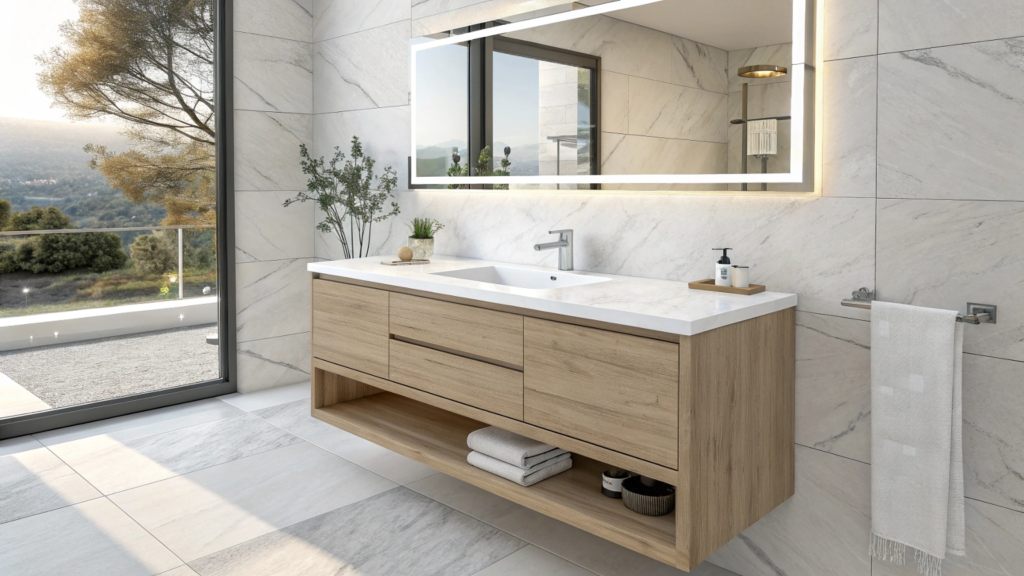
I have priced thousands of vanities in my career. The relationship between size and price is not linear; larger vanities are not just double the cost of smaller ones. This is because the countertop material—usually quartz or granite—is a significant cost driver, and its cost scales with size. A large, double-sink vanity over 60 inches wide often requires a seam in the countertop or a custom-cut slab, which raises the fabrication cost.
However, for a wholesaler like Mason, the size choice is often limited by the existing bathroom layout. She might need many 30-inch vanities for standard rooms and fewer 60-inch units for suites. The bulk discount is usually applied across the entire order quantity, but the unit cost for the larger pieces remains higher. I advise clients to focus on standardizing the smaller, higher-volume units to maximize the savings. Customizing the design of a 24-inch vanity for 200 rooms will have a much bigger negative impact on cost than customizing one 72-inch unit for the penthouse suite.
How much do different types of bathroom vanities cost in bulk?
It’s confusing to compare floor-mounted and wall-mounted prices. I will clarify these cost factors for you.
Different vanity types have different bulk unit costs:
- Free-Standing/Floor-Mounted bathroom vanities : $200–$500
- Wall-Mounted/Floating bathroom vanities : $350–$700 (Higher labor cost for installation)
- Custom bathroom vanities: $600–$1,500 Wall-mounted vanities have a higher unit cost because they require stronger internal framing.
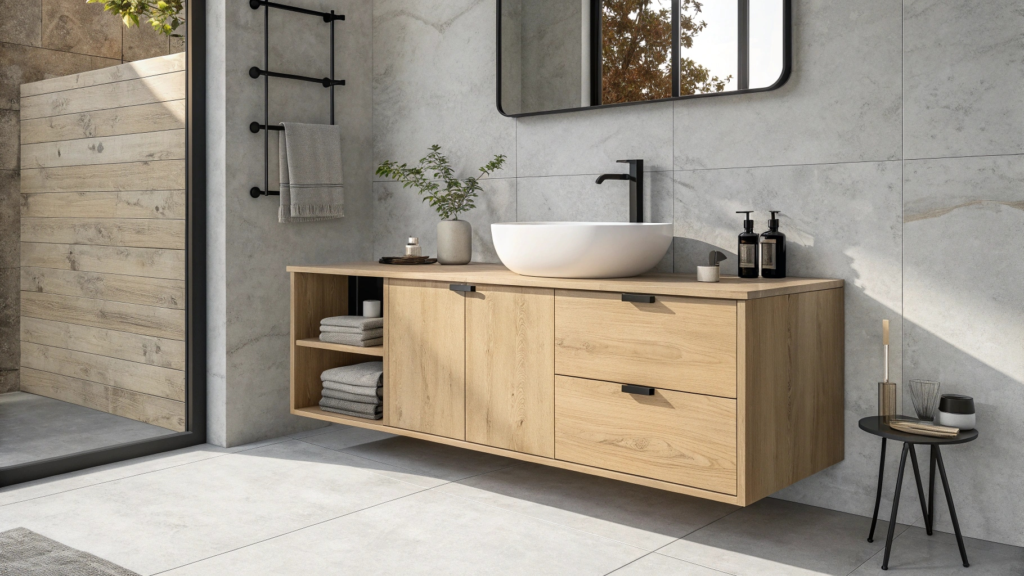
In my experience, the style of the vanity profoundly impacts both the material cost and the installation labor. Floor-mounted vanities are simpler and cheaper to manufacture. They just need a toe kick or legs, and installation is easier for the hotel maintenance crew—just set it and connect the plumbing. Wall-mounted, or floating, vanities are a different story. They require a much more robust internal frame and specialized wall-mounting hardware to support the weight of the vanity, sink, and countertop, plus whatever a guest might lean on it. This extra reinforcement increases the material and factory labor cost, which adds about 20% to 50% to the unit price.
Furthermore, the labor cost for installing a wall-mounted vanity in a hotel is higher because it demands more precision and time on-site to ensure it is level and securely mounted, especially when doing many rooms. Custom cabinetry, built to perfectly fit unique nooks or complex layouts, has the highest cost because of the non-standard production line work and the specialized design fees.I recommend selecting a Freestanding model for standard rooms and only using Wall-Mounted or Custom for suites. This mixed strategy helps keep the overall project cost manageable.
How much do bathroom vanities cost by material for a wholesale purchase?
It’s frustrating when a “deal” ends in early rot. I can help you choose the material that masters the molding right.
The choice of material heavily influences the wholesale unit cost and lifespan:
- MDF/Particle Board: $150–$300 (Lowest cost, poor moisture resistance)
- Plywood/Solid Wood: $250–$600 (Mid-range, good moisture resistance)
- Stainless Steel/Solid Surface: $500–$1,200 (Highest cost, best durability) Hotels should prioritize Plywood or Stainless Steel for low lifecycle cost.
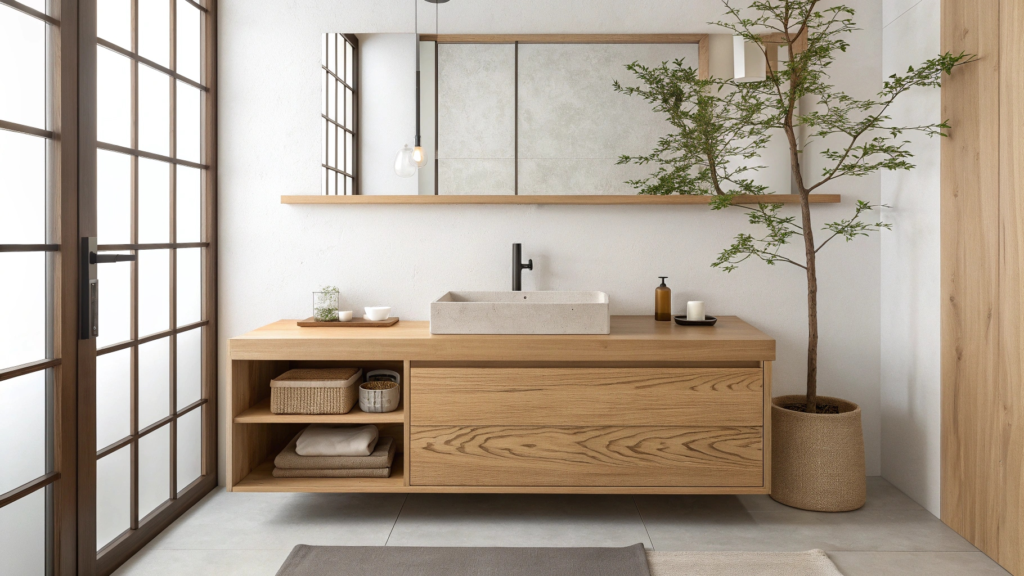
Plywood, especially marine-grade or multi-layer plywood, is the sweet spot for wholesalers like Mason. It offers excellent moisture resistance and a good balance of cost and durability. Stainless steel is the most durable, resisting water and mold completely, but the material and fabrication costs are much higher. Solid wood is beautiful but requires careful finishing to resist warping and is often too expensive for bulk hotel replacement. When a wholesaler gets a bulk quote, the material must be clearly defined. A quote for “wood” can hide the use of cheap particle board. Wholesalers must specify the exact material grade to secure the lowest lifecycle cost.
What is the labor cost to replace a bathroom vanity?
It’s common to underestimate installation costs. I will show you how to calculate the real labor expense.
Labor for a full vanity replacement typically costs between $150 and $450 per unit. This includes plumbing disconnection, securing the new vanity, reconnecting the plumbing, and sealing. The cost varies based on location and the complexity of the plumbing or if any wall modifications are needed.
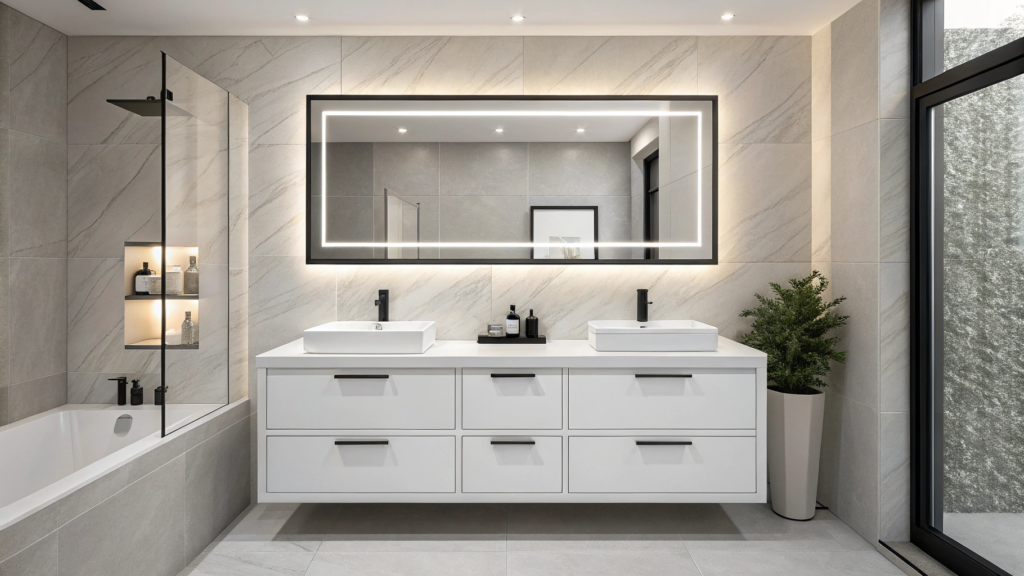
Labor is a huge part of the total replacement cost, and it is the part Emma worries about most because it affects her renovation schedule. In major cities, an experienced plumber and installer might charge $75 to $150 per hour. Since a full replacement, including removal and disposal, takes 2 to 4 hours per unit, the labor cost can easily reach $450.
For wholesale projects, I always advise clients to negotiate a fixed, all-inclusive rate per unit for a bulk replacement. This reduces the risk of open-ended hourly billing. The complexity of the vanity also matters; for example, a wall-mounted vanity takes longer to install and costs more in labor. If the existing plumbing does not perfectly align with the new vanity’s cutout, the labor cost will increase for on-site modifications. This is another reason why a high-quality, reliable manufacturer is essential—their products should be consistent, making installation faster and cheaper.
How much to charge to remove a bathroom vanity?
For a large hotel renovation, managing waste is a huge logistical and cost issue. When I was running my company, I learned that the removal process must be systematic to avoid high costs. The demolition process itself is quick: a few minutes to disconnect and a few more to break up the unit. The real cost comes from disposal. You must pay for a dumpster or waste removal service, and those charges are based on volume and weight.
A single-sink vanity can weigh 150-250 pounds. For a 100-room hotel, you are removing 100 vanities, which is a massive amount of waste. The material also affects the cost: a laminate vanity is easier to dispose of than a unit with a heavy granite or marble top, which may require separate recycling or disposal methods. The price to remove the vanity can also change based on the hotel’s location. Disposing of construction debris in a major urban area is much more expensive than in a rural area. I recommend getting a separate quote from the waste management company for the entire project. This gives you a clear number for disposal and lets you better negotiate the labor cost for removal with your installer.
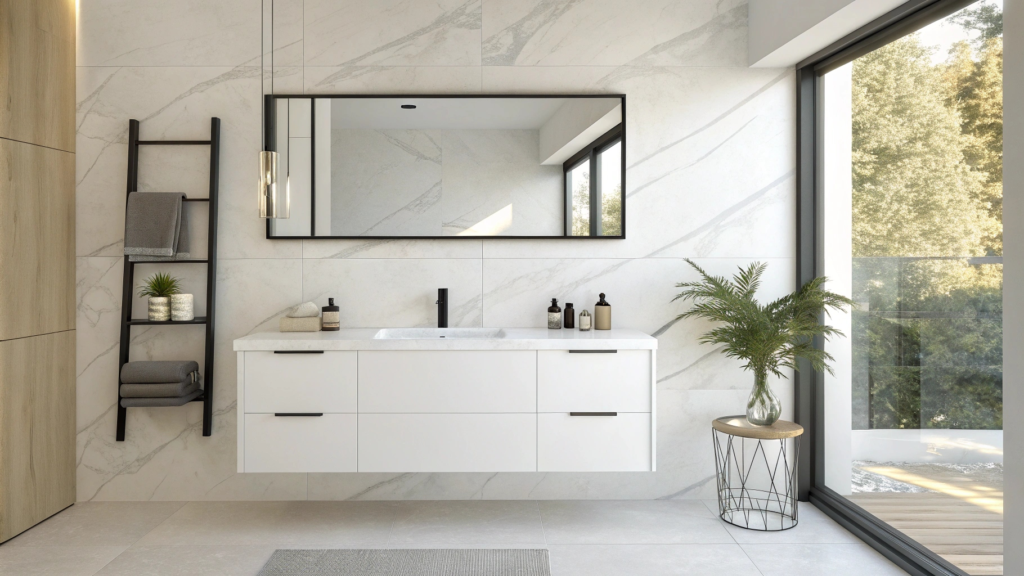
My many years in the factory and trading space showed me that there is no single recommended size for bathroom cabinets. The size is always customized according to the specific space. For high-volume buyers like a large hotel chain or a major distributor, customization offers a competitive edge. It allows the vanity to be built to the exact millimeter, eliminating the need for filler pieces and simplifying on-site installation, which Emma values highly. However, this comes at a cost. The factory must stop its standard production line, adjust machinery, and potentially order non-standard materials, which increases the Minimum Order Quantity (MOQ) significantly.
I generally recommend that customization is only financially viable for orders exceeding 200 units. Below that, the cost premium often outweighs the benefit. For a boutique hotel where the unique design is part of the brand, customization is a must, but for a budget-focused wholesale inventory, it is a bad investment. Always perform a cost-benefit analysis comparing the premium of customization versus the labor cost of fitting a standard size. My final advice is this: use customization to solve a major design flaw or to cement a high-end brand look, but rely on market-standard sizes for everything else to keep your costs down and your logistics simple
How much does it cost for a custom bathroom vanity in bulk?
Customization is not just a style choice; it is a major budget decision. You must know what makes the price jump.
Custom vanities for bulk hotel orders cost 25% to 75% more than standard units, ranging from $600 to $1,500+ per unit. This extra cost covers specialized design, non-standard materials, unique hardware, and the inefficiency of producing a small, custom batch in a mass-production factory.
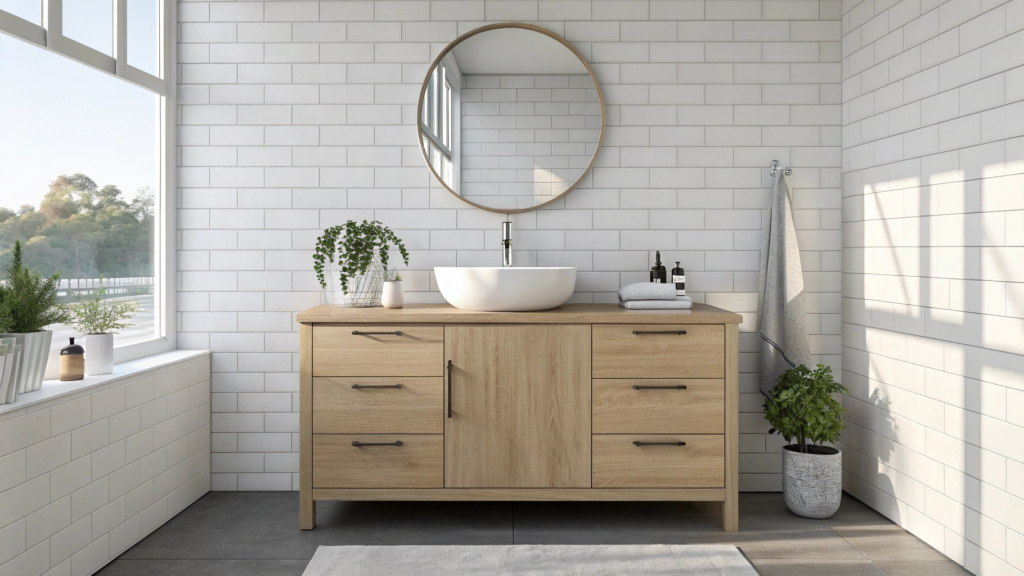
When a hotel demands a custom vanity—maybe a specific wood veneer color or a unique countertop profile—the factory has to stop its regular line. This “line interruption” is costly. Custom work requires a dedicated design and engineering team to create new drawings, special tooling, and separate quality control checks. I’ve seen custom orders where the factory had to manually cut and finish the cabinets because the standard machines were not set up for the unique size. This slows down the whole process and increases the factory labor cost.
For a wholesaler, the key is to ask for “semi-custom,” which means keeping the cabinet box and sizes standard and only changing the door style or hardware. This keeps the cost lower. If a full custom unit is needed, like integrated lighting or smart mirrors, the cost goes up again. I tell my clients that a custom vanity should only be used where a standard unit simply cannot work, such as in a Presidential Suite. For the rest of the hotel, sticking to a proven wholesale model is the only way to control costs.
How Much Does It Cost to Ship Bathroom Vanities in Bulk?
It’s a big expense that can surprise you. I will explain the key shipping cost factors.
Shipping a container of bathroom vanities in bulk (e.g., 200 units in a 40-foot container) can range from $2,500 to $10,000 or more, depending on the route, current fuel prices, and port fees. Shipping costs are best calculated on a per-unit basis, often adding $15 to $50 to the final unit cost.
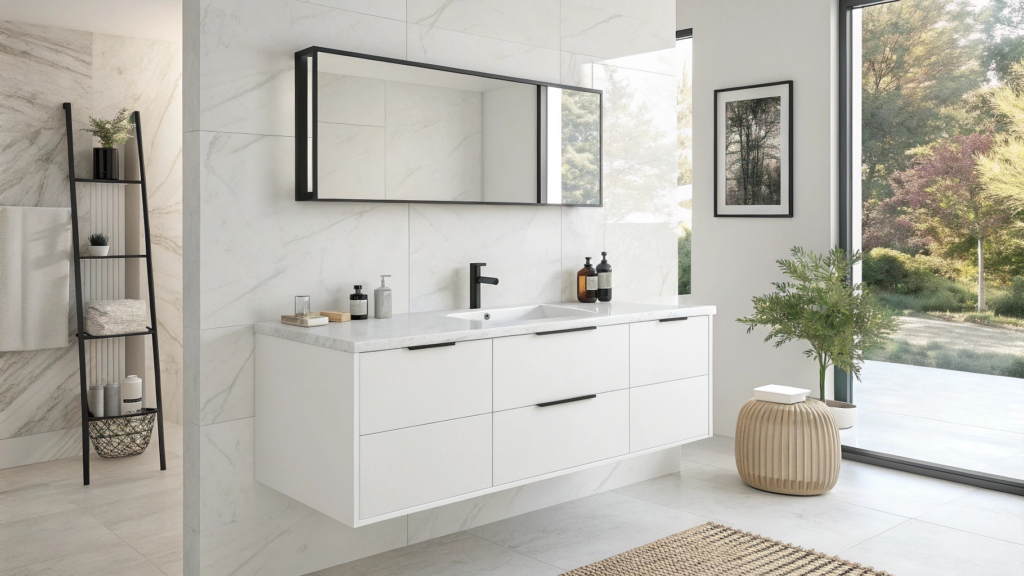
Shipping is a major factor in the total cost, especially for bulk international orders. A 40-foot container can usually hold about 150 to 200 standard-sized vanities, depending on the packing method. The freight cost for this container can fluctuate dramatically based on global economic conditions.
For instance, I saw shipping costs nearly triple during a recent global supply chain crisis. For a wholesale buyer, the best strategy is to negotiate the price terms as DDP (Delivered Duty Paid) or CIF (Cost, Insurance, and Freight). This forces the manufacturer to take responsibility for all shipping and customs costs up to the port or delivery point, giving you one fixed price per unit. The cost per unit is much lower when the container is fully loaded.
Wholesalers should always plan orders to fill entire containers to maximize efficiency. A half-empty container means you are paying full freight for less product.I advise my clients to calculate the total cost: (Unit Cost + FCL Shipping Cost per Unit + On-Site Assembly Labor) versus (Unit Cost + LCL Shipping Cost per Unit + Minimal Assembly Labor). This calculation is vital to finding the most cost-effective solution for a large project.
How to Choose a Manufacturer with Bulk Supply and Hotel Project Experience?
It’s difficult to trust a new manufacturer. I will share my expert advice on vetting suppliers.
Choose a manufacturer with:
- Hotel Case Studies: Evidence of past large-scale, on-time project delivery.
- Quality Certifications: ISO or FSC for materials and process control.
- Guarantees: A strong, long-term product warranty and post-sale service.
- Bulk Capacity: The ability to produce 50+ units consistently.

As the founder of georgebuildshop, I know that a good manufacturer is the key to mastering molding right. A true hotel project supplier understands the critical importance of a consistent finish across hundreds of rooms. They must have robust quality control to avoid the variations in color or size that cause project headaches for Emma. I learned the hard way that a low price from a small factory often means high-cost rework on-site.
The best manufacturers are willing to share detailed case studies, proving they can handle the logistics of large, timed deliveries. They should also provide a transparent maintenance guide and a long-term supply guarantee. For example, if a hotel needs a replacement vanity 5 years later, the manufacturer must still have the mold or the design spec to produce an exact match. Wholesalers must visit the factory, or at least have a detailed third-party audit, to confirm their claimed bulk production capacity is real and not just marketing talk.
Conclusion
The total cost to replace hotel vanities is $400 to $2,500 per unit, and a 20-40% bulk discount is possible. Look past the unit price; focus on quality materials, clear logistics, and a reliable, experienced manufacturer to ensure a low lifecycle cost.


